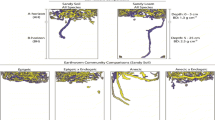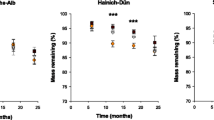Abstract
Effects of leaf litter of beech (Fagus sylvatica L.) and stinging nettles (Urtica dioica L.) and of the endogeic earthworm species Octolasion lacteum (Örley) on carbon turnover and nutrient dynamics in soil of three beechwood sites on a basalt hill (Hesse, Germany) were investigated in a laboratory experiment lasting for about 1 year. The sites were located along a gradient from basalt (upper part of the hill) to limestone (lower part of the hill) with an intermediate site in between (transition zone). At the intermediate site U. dioica dominated in the understory whereas at the other sites Mercurialis perennis L. was most abundant. The amount and composition of organic matter was similar in soil of the basalt (carbon content 5.9%, C/N ratio 13.8) and intermediate site (carbon content 5.6%, C/N ratio 14.3) but the soil of the intermediate site produced more CO2 (in total +17.5%) and more nitrogen (as nitrate) was leached from this soil (in total +55.6%). It is concluded that the soil of the intermediate site contains a large mobile carbon and nitrogen pool and the formation of this pool is ascribed to the input of U. dioica litter. Leaf litter of U. dioica strongly increased NO3 –-N leaching immediately after the litter had been added, whereas nitrogen was immobilized due to addition of beech litter. Despite the very fast initial decomposition of nettle litter, the increase in CO2 production due to this litter material was only equivalent to 20.1% of the amount of carbon added with the nettle litter; the respective value for beech litter was 34.8%. Earthworms altered the time course of carbon and nitrogen mineralization in each of the treatments. In general, earthworms strongly increased mineralization of nitrogen but this effect was less pronounced in soil of the intermediate site (treatments without litter), which is ascribed to a depleted physically protected nitrogen and carbon pool. In contrast, their effect on the total amount of nitrogen mobilized from nettle litter was small. Earthworms significantly reduced CO2 production from soil of the intermediate site (treatments without litter) and it is concluded that earthworm activity contributes to the restoration of the depleted physically protected carbon pool at this site.
Similar content being viewed by others
Author information
Authors and Affiliations
Additional information
Received: 21 April 1996
Rights and permissions
About this article
Cite this article
Scheu, S. Effects of litter (beech and stinging nettle) and earthworms (Octolasion lacteum) on carbon and nutrient cycling in beech forests on a basalt-limestone gradient: A laboratory experiment. Biol Fertil Soils 24, 384–393 (1997). https://doi.org/10.1007/s003740050262
Issue Date:
DOI: https://doi.org/10.1007/s003740050262




